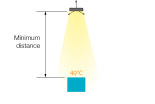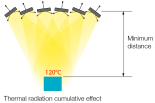Sarà curioso sapere, ad analisi concluse, se il colore della fusoliera abbia influito in qualche modo.
Under the Spotlights
Two recent events with damage to the passenger windows of the aircraft were reported to Airbus. Similar events also happened on non-Airbus aircraft. The damage was caused by the heat of spotlights used during promotional filming sessions. One of these events could have had serious safety consequences as damage was not detected on ground, and caused some window panes to detach from the aircraft during the next flight.
This article describes this event in more detail and how to prevent heat damage due to exterior lighting. It also recommends checking the condition of the aircraft before it returns to service.
CASE STUDY
Event Description
An A321neo aircraft was performing a positioning flight before several sectors of operations. A limited number of people including some cabin crew members were on board. The aircraft was climbing toward its target altitude. At 10 000 ft, one of the cabin crew noticed an excessive amount of cabin noise and cold temperature while walking toward the empty middle part of the aircraft. He discovered that one of the windows on the left side of the cabin appeared to have slipped down from its usual position and that the window seal was flapping in the outside airflow (fig.1). He immediately informed the flight crew who decided to descend to 9 000 ft and to perform an in-flight turnback. The aircraft landed safely and without further incident.
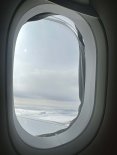
When on the ground and with the aircraft parked, the flight crew performed an inspection of the aircraft exterior. They observed that two windows were missing and one was dislodged (fig.2). Damage to the lower side of the left stabilizer, probably due to an impact of a departing part, was also noticed. Further inspection revealed that two additional windows were damaged on the left side of the fuselage and one window also showed signs of damage on the right side of the fuselage.

Event Analysis
One day before the event, there was a filming session inside the aircraft, around the middle cabin area. There were 6 halogen (tungsten) lamphead spotlights, rated at 12 kW, placed outside the cabin windows to light the area being filmed. The 6 spotlights were first located on the right side of the aircraft at a distance between 6 to 9 meters from the fuselage, close to the overwing emergency exits, with the light beams focussed on the same area of fuselage (fig.3). The lights were then moved to the left side of the aircraft for the second part of the filming session.

Heat damage
The combined power of the 6 lamps in the halogen lighting setup was 72 kW. The exposure of the fuselage area to the spotlights lasted more than 4 hours on each side of the aircraft. The heat produced by the infrared radiation from the halogen spotlights damaged several cabin windows. This damage was not detected prior to the next flight.
The damage found on the affected windows during post-flight inspection included:
- Two window assemblies completely missing (one pane was retrieved on the runway)
- One window with missing outer pane
- Deformation of several other window panes
- Window seals in degraded condition
- Visible burn marks
- Melted foam ring at the interface between the window and the cabin lining.
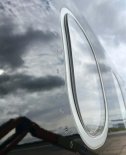
A cabin window assembly is typically composed of one inner and one outer pane made of stretched acrylic contained in a window seal (fig.6). An additional transparent lining (not shown in the illustration) is present on the cabin side to protect the inner pane from impacts or scratches from the passenger side.
A plug-type structural element
The cabin window assembly is a plug-type structural component. In other words, it is positioned from the inside of the aircraft and its size is bigger than the window frame so that the differential pressure pushes it against the window frame. The window assembly is maintained in place by a retainer, which is attached to the window frame by bolts.
A fail-safe structural part
Each cabin window pane (i.e. both the inner and outer panes) are able to independently sustain the maximum cabin differential pressure usually experienced during a flight.
The outer pane sustains the loads. A small vent hole on the inner pane lets the cabin pressure into the space between the two panes. This prevents the inner pane from sustaining pressurization cycles on each flight. The inner pane is, therefore, not exposed to structural fatigue.
If the outer pane fails during a flight, the inner pane is designed to sustain the differential pressure loads and maintain the cabin pressure, which allows the continuation of the flight. The window assembly can then be replaced when the aircraft is back on the ground.
Risks associated with abnormal heat exposure
Shrink-back effect of acrylic
Cabin window panes are manufactured from a thick acrylic sheet that is heated to become softer, then stretched until the required thickness is reached. In normal operating temperature conditions, the acrylic remains in a stable state. However, if excessive heat is applied to a stretched acrylic object, the acrylic softens and the object tends to shrink back to its original shape.

Risk of window pane ejection
If the passenger window panes are exposed to an excessive amount of heat, the panes may start to shrink and could become smaller than the window frame. If a damaged window is not detected before the aircraft returns to service, as in the event described earlier, there is a risk that the cabin pressure differential at altitude will force the affected window pane outwards, causing cabin air pressure leaks and eventually the ejection of the window pane (fig.8). If both the inner and outer panes are affected by the heat damage, the complete window assembly could fail and be ejected.
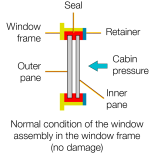
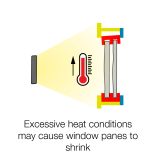
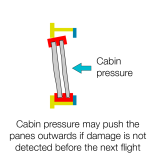
PREVENTING HEAT DAMAGE
When performing a filming session or photoshoot that requires the use of artificial lighting in close proximity to an aircraft, the following recommendations will prevent heat from the lights causing damage to the windows and fuselage.
Avoid using high thermal radiation lighting
Airbus recommends not to use high thermal radiation lighting devices, such as halogen (tungsten) or HMI lighting, during photoshoots or filming sessions outside or inside an aircraft. This type of lighting device emits a large amount of thermal energy. Only use low energy lighting devices, such as LED lights, which provide good lighting capabilities with low heat emission.
Limit exposure and regularly monitor the surface temperature
Switch off any lighting devices when not necessary to limit the exposure time to the minimum.
Even though Airbus aircraft materials have been qualified for use in elevated temperature environments, for example, taking into account operations or storage in hot weather regions, Airbus recommendation is to make sure that the surface temperature of cabin and passenger windows, fuselage, interior equipment and all aircraft parts exposed to the lighting sources, are monitored and do not exceed 55°C.
Beware of the thermal radiation cumulative effect
Even if the minimum distance to the subject defined by the lighting device instructions is respected, when multiple lighting units are used at the same time, there is a thermal radiation cumulative effect that may cause overheating and damage to the aircraft.
For example, one halogen lighting unit located at the minimum recommended distance, and pointed at the fuselage may increase the surface temperature of the fuselage to 40°C (fig.9).
Using six similar halogen lighting devices simultaneously, which are located at the recommended minimum distance and all pointed at the fuselage, may quickly raise the surface temperature to 120°C due to the cumulation of the thermal radiation emitted from each light. This high temperature may cause damage to the object.
Check the aircraft for damage before return into service
After the filming session or photoshoot is finished, Airbus recommends performing a visual inspection of all cabin windows that were exposed to the lightning to check they are free of any damage or distortion before returning the aircraft to service.
